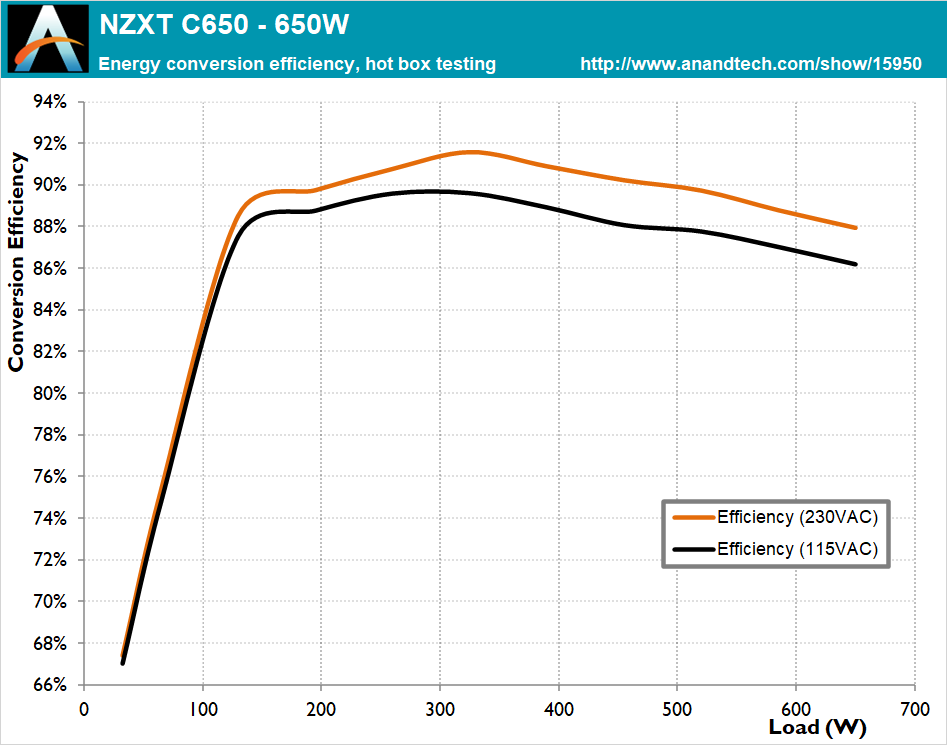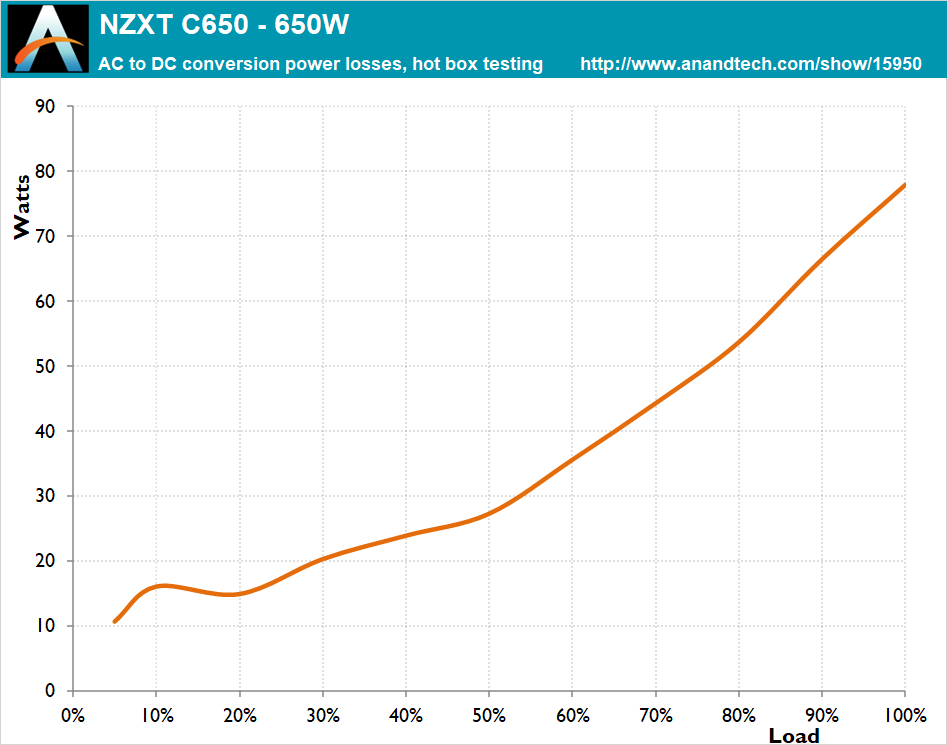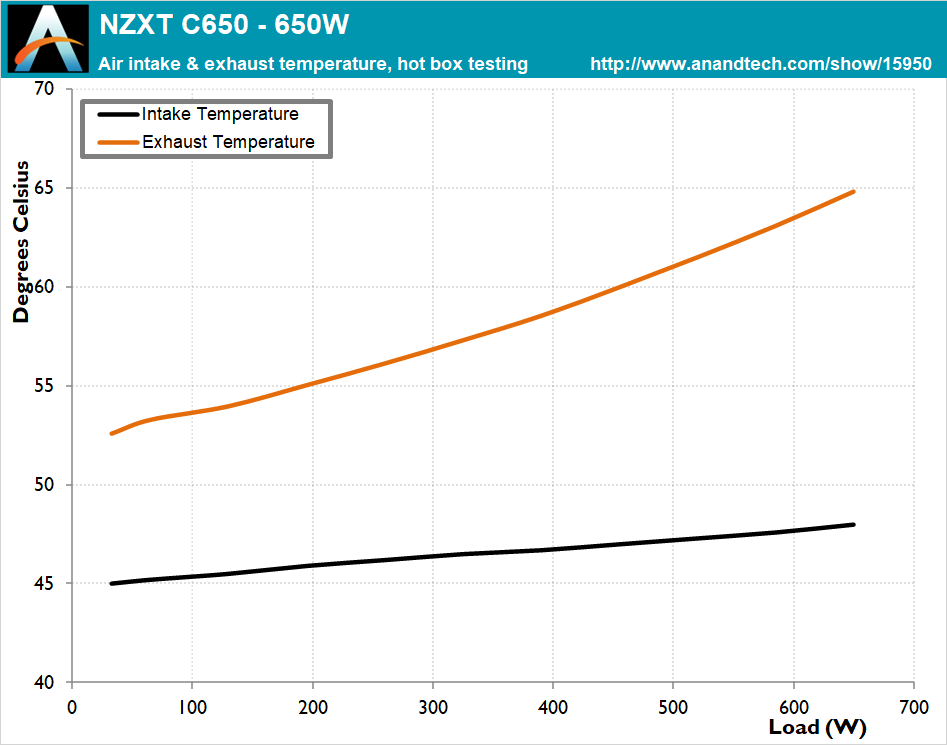The NZXT C650 650W PSU Review: Designed To Last
by E. Fylladitakis on August 11, 2020 8:00 AM EST- Posted in
- Cases/Cooling/PSUs
- PSUs
- 80Plus Gold
- NZXT
- 650W
- Modular
Hot Test Results
As we can see in the following tables, the NZXT C650 delivers great power quality. The maximum voltage ripple on the 12V line is 28 mV, an unimpressive figure nowadays, but less than a quarter of the ATX design guide's recommended 120 mV limit. Ripple on the secondary 3.3V/5V lines is considerably worse, reaching 28 mV on the 5V line with a recommended maximum at 50 mV. We can notice the same pattern on voltage regulation, with the 12V line very tightly regulated at 0.7% and the regulation on the secondary 3.3V/5V lines reaching slightly over 2%.
| Main Output | ||||||||
| Load (Watts) | 130.6 W | 326.19 W | 486.33 W | 647.57 W | ||||
| Load (Percent) | 20.09% | 50.18% | 74.82% | 99.63% | ||||
| Amperes | Volts | Amperes | Volts | Amperes | Volts | Amperes | Volts | |
| 3.3 V | 1.78 | 3.33 | 4.45 | 3.33 | 6.67 | 3.29 | 8.89 | 3.27 |
| 5 V | 1.78 | 5.05 | 4.45 | 5.01 | 6.67 | 5 | 8.89 | 4.97 |
| 12 V | 9.6 | 12.05 | 24.01 | 12.04 | 36.01 | 11.97 | 48.02 | 11.96 |
| Line | Regulation (20% to 100% load) |
Voltage Ripple (mV) | |||||
| 20% Load | 50% Load | 75% Load | 100% Load | CL1 12V |
CL2 3.3V + 5V |
||
| 3.3V | 2% | 10 | 16 | 20 | 22 | 12 | 24 |
| 5V | 1.6% | 12 | 16 | 22 | 28 | 14 | 24 |
| 12V | 0.7% | 16 | 20 | 22 | 28 | 30 | 20 |
Operation in high ambient temperatures does not affect the performance of the NZXT C650 considerably, regardless of the load. The average nominal load range (20%-100%) efficiency drops by 0.8% regardless of the input voltage, going down to an average of 89.8% (230 VAC) / 88.1% (115 VAC). There is very little change across the entire load range, suggesting that the components of the PSU are practically unaffected by the high ambient temperature. The component temperatures are high but not overly so.
As expected, the thermal control circuitry of the NZXT C650 correctly detects the high ambient temperature inside our hotbox and adjusts the fan’s speed accordingly. The NZXT C650 is not silent under these operating conditions, with the fan’s speed gradually increasing along with the load. Nevertheless, the sound pressure level tops out at just 50.2 dB(A), a figure significantly lower than what we would expect from a unit with a powerful 120 mm fan.















34 Comments
View All Comments
YB1064 - Tuesday, August 11, 2020 - link
It would be interesting and minimal effort on your part to post a PSD (power spectral density) plot. You can use the ~$300 Red Pitaya (STEMLAB) as a spectrum analyzer (DC-60MHz+). This is useful additional information for those concerned about switching noise.If you are not familiar with the Re Pitaya, here it is:
https://www.redpitaya.com/f135/spectrum-analyzer
E.Fyll - Tuesday, August 11, 2020 - link
Perhaps PSD measurements would be academically interesting but do not affect anything that would actually concern the end-user of a PSU, with maybe the exception of identifying excessive phase noise that would be easily identifiable in the time domain and I would see it anyway. It also is excessively difficult to take a proper PSD measurement off a device with a switching power circuit, especially of non-discrete signals, and would mean nothing in the end because it would be impossible to identify what is actually causing any given noise. The only stage that taking PSD measurements of a PSU is during its development stage, to test for EMC compliance and to empirically tweak the platform (if necessary). Other than that, PSD is very useful in communications but not in power electronics.YB1064 - Wednesday, August 12, 2020 - link
Thank you for the clarification.rocketman122 - Tuesday, August 11, 2020 - link
nothing is durable and lasts here in the middle east. dust will break down anything and everything. horrible climate.hehatemeXX - Tuesday, August 11, 2020 - link
If they make a complete passive PSU, that does not get crazy hot, and has a rather large heatsink... maybe ;)Showtime - Tuesday, August 11, 2020 - link
Noctua, and other companies have fans that are sealed. Good ones should be able to deal to deal with dust, and heat just fine with some cleaning. Idk if it's your radiators that go bad, but I'd run a tower cooler since the fins are easy to clean. Go with the bigger coolers on your graphics card. The rest of it is dusting when needed. It's not as bad here in California, but we get those 100c days, but my Noctua cooler, and triple fan GPU handle it fine.GreenReaper - Wednesday, August 12, 2020 - link
100C days? Man, global warming is worse than I thought! :-DWe're getting 34C here and it's bad enough; but we lack A/C in UKia.
MrVibrato - Monday, August 17, 2020 - link
Days with 100C? Press F to pay thermic respects...Samus - Wednesday, August 12, 2020 - link
I used to live in San Diego and the salt in the air (I was a block from the ocean) would corrode the inside of PC's like acid. The solution was to go passive cooled on the secondary components and liquid cooled on the primary. I still had a fan inside the otherwise sealed case to distribute air and help the water blocks absorb ambient heat, and the case was always very warm (around 110F-120F under load, down to 80F at idle at a 70-75F ambient)The radiator 'tower' was external to the entire case, and since it was all aluminum and the fan bearings were sealed, never had a problem.
All of this was NOT cheap but it was cheaper than replacing every piece of steel or soldered component inside the case every few years.
Amoro - Tuesday, August 11, 2020 - link
The main downside to this PSU is the lack of a second 8-pin for the CPU. Most X570 motherboards seem to require an 8 and a 4 pin.